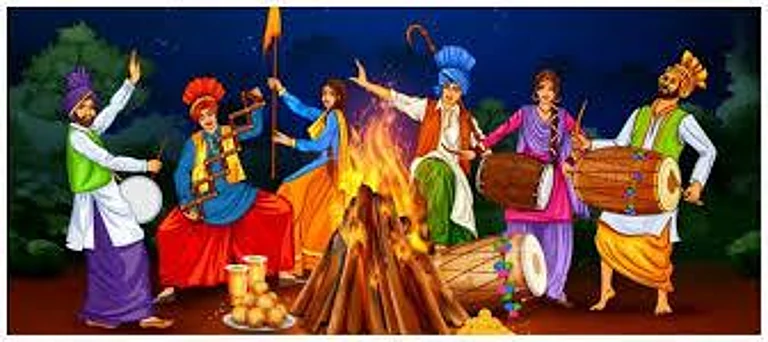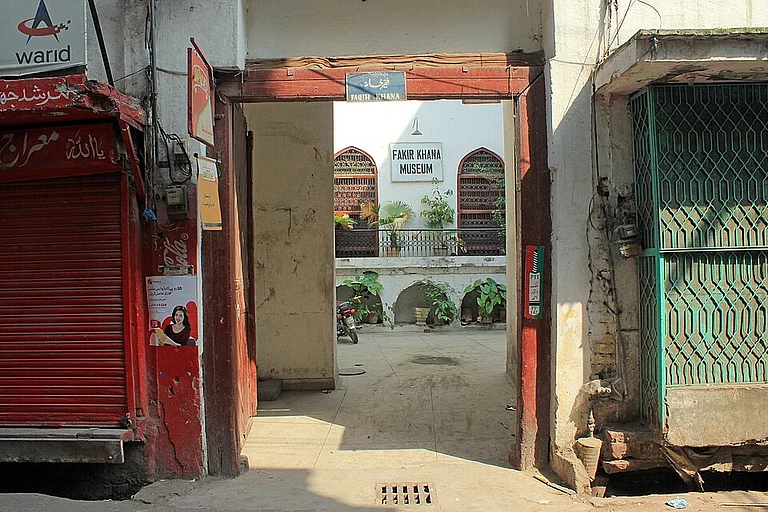The sound of Indian music was not recorded until 1902. The earliest known recorded song in human history was a French folk—“Au Clair De La Lune” (By the Light of the Moon) in 1860 on a Phonoautograph invented by Edouard-Leon Scott de Martinville. After the etchings on the Phonoautograph were transcribed into playable audio at the Lawrence Berkley National Laboratory, it is now accepted as the first recorded human voice in history, predating Edison’s cylinder phonograph recordings by at least 30 years.
On November 8, 1902, Gauhar Jaan recorded Raag Jogiya for the Gramophone Company, making it the first recording of the Indian music for a listener not sitting around the singer. Not much is known about the Punjabi music for the next 20-25 years. Though the first recordings of Punjabi devotional music were that of dastango and dhadhi groups in 1930s, they have been lost in the mists of the time. If they still exist, they are not in the public realm. Their sound, structure and characteristics will remain a mystery. Among the popular voices and faces of Punjabi music from its inception, K L Sehgal made his debut in 1932; Shamshad Begum in 1937; Mohammad Rafi in 1941 and Surinder Kaur in 1943.
Master Madan died on June 5, 1942. In his voice, we hear perhaps two of the oldest recorded gurbani shabad—the Sikh hymns—sung in the late 1930s or early 1940s. His voice also preserves the sound of two of the oldest recorded Punjabi songs.
He can be remembered as a child marvel, and also probably the first victim of professional jealousy in the known, recorded and printed history of Punjabi music.
Born in 1927, he belonged to the era when the litmus test of a singer’s vocals was the medium of the live performance of Hindustani classical music. His influence on the audience, bolstered by the royals’ patronage, can be gauged from his remuneration—Rs 80 for a small and up to Rs 300 for a more elaborate performance. In the times of British Raaj, the monthly salary of a government employee was Rs 60-70.
Through him can be seen the harmonious intricacies of society of the 1930s. He was born to Sardar Amar Singh and Puran Devi in the village Khan Khana near Nawan Shahar in Punjab. His elder sister, Shanti Devi, had mentioned in the yore that Madan always kept a picture of Guru Nanak Dev wrapped in silk with him. Master Mohan Singh, his brother and one of his mentors older than him by nearly a decade, made the duo for the joint presentations. Amar Singh was from a village but moved to the city of Shimla to pursue his government job where he continued to train his two sons in music. In 1942, Shimla was the summer capital of British India (Shimla was also the capital of East Punjab until 1966 before Himachal Pradesh was created). They lived in the Butail Building in the lower bazaar. Master Madan first went to Sanatan Dharam School and matriculated from Ramjas, Delhi.
The village Khan Khana, his birthplace, is located by the banks of river Sutlej. It is named after Abdul Rahim Khan-e-Khanan, one of the navratnas (nine gems) of the Mughal emperor Akbar. Better known as Rahim, he is popularly remembered for his couplets—the dohe.
Khan Khana is about 25 kilometers from another small town Raahon—birthplace of the legendary music director of Bollywood, Mohammad Zahur Khayam, popularly known as Khayam. Interestingly, Khayam is also reported to be born in 1927—10 months earlier than Master Madan. Umrao Jaan (featuring Rekha—1981), Razia Sultan, Noorie, and Yash Chopra’s Kabhi Kabhie have immortalised Khayam saab. The‘dil cheez’ of Umrao Jaan or ‘dil mein khayaal’ of Kabhi Kabhie will resound in Bollywood as long as it exists.
Both Khan Khana and Raahon are nearly one hour away from Sham Churasi, a small town of about 6,000 people in the district of Hoshiarpur. It is the founding place of Sham Churasi gharana of classical music in the 16th century by the peers and fellows of Tansen in Akbar’s court. It is considered the cradle of classical singing form ‘dhrupad’. Sham Churasi gharana is one of the four classical music houses of Hindustani classical music originated in East Punjab. The other three are Patiala, Kapurthala and Talwandi. It sounds like one thousand years ago, but the popularity of classical forms of music (including ‘tappe’ being one of those art forms which we have now accepted as folk) existed until the partition.
Master Madan was surrounded by these echoes of music.
The young Madan first performed kaafi ‘vandan hai shaarda naman karun’ in Solan before he turned five. Within a few years, at the age of nine, he was the star artist at the famed festival of classical music in Jalandhar—the Harvallabh Sangeet Sammelan. As the story goes, he became a sensation very quickly. The then reigning star Kundan Lal Sehgal (from Jalandhar) was a fan of the young boy. According to the witnesses of the time, when Mahatma Gandhi visited Shimla in 1940, people did not turn up to see him in expected numbers because they were attending Master Madan’s concert. By the age of 14, Master Madan as a solo artist was a pan-India star and on the panel of All India Radio as a regular performer of classical music along with the greats like Ustad Bade Ghulam Ali Khan, Dina Qawaal, Mubarak Ali Fateh Ali et al. Prithvi Raj Kapoor (the patriarch of Bollywood’s Kapoor family) is reported to have visited the boy for collaboration which did not happen because of the singer’s demise.
His two shabads, the Sikh hymns—‘chetna hai to chet lai’, and ‘man ki man hi mahe rahi’—penned by ninth guru Guru Tegh Bahadur, are present on the internet. Also in existence are his two Punjabi songs—‘raavi de parle kandhe ve mitra, vassda ae dil da chor, and, baagaan vich peenghaan payiaan’. These four recordings are a part of a total of eight left on the globe. Two ghazals (Yun na reh reh kar humein tarsaaiye/Hairat se tak raha hai jaane wafa mujhe) and two thumris complete the list. Listening to the hymns sung by him is a revelation of how the devotional music may have changed with the application of the harmonium (a French instrument) and raagi groups made up of three or four people now. Interestingly, the harmonium was banned in India in the Indian Independence movement. It was banned at All India Radio from 1940-1971.
Who killed Master Madan? No one knows. There was no investigation. No one was ever convicted. No one was ever named. History only knows that someone took his life. It was long before caste, politics, religious perpendicularity or gang war was cited as the motive behind the acts of eliminating the rival in the field of music. It has been accepted without opposition that he was eliminated because he was the best, or the most popular in his craft at that time. Someone silenced his voice by mixing a poison, popularly rumored to be Mercury in the milk he used to drink after every stage performance, or another slow poison in the food, (one version also suggests that a nautch girl lured him and then gave him a poisoned paan).
After Master Madan was poisoned, his active life lasted for only about three months. He spent his last days in the family home in Shimla attended to by his mother. One day, he told his mother, with his head in her lap—‘My time has come. People are coming on the horses to take me.’ Among the accolades showered upon him during his short life were many medals of gold and silver given by the royal kings. Master Madan was cremated wearing all of them.
Until six-seven years ago, a home stood in the village Khan Khana, with ‘Mohan Niwas’ inscribed on it in Urdu. The house was made of old, nanakshaahi red bricks and was named after Master Mohan Singh. The house may not be standing today in the same state.
Punjab is a palimpsest embracing many more within. This manuscript has been effaced (or defaced) every half a century or so, but the traces of the original remain. No tale has happened for the very first time on that soil. Master Madan happened long before the ‘suparis’ were given to the weaponised men who covered their faces as they did the job for the people who paid for or ordered it. Perhaps a middle-aged woman, or a servant, or a friendly stage manager, for little money at the behest of a rival was enough to do the job.
Today, about 1 per cent of the Punjab youth may have heard about ‘dhrupad’ or Madan or Sham Churasi house of music. They might just walk away by saying—who cares! ‘Dhrupad’ scholars of Sham Churasi gharana may be another layer of soil Punjab will bury (or has done already) under the weight of novel aspirations generated by the time. Having spent half of my life in Kapurthala, I had never heard before that the city had a place in a classical form of music.
Not much is known about professional jealousy in music before the era of recorded music; however, after humanity started preserving the notes, there have been many anecdotes —some of them fatal. Ghazal maestro Jagjit Singh stated in one of his interviews that, in the olden times, singers would not take even ‘paan’ from others’ hands because of the fear of poison or toxin.
Paan, or paani—if mixed with anything other than melody, do not represent the world of music well.
(Ramandeep Kahlon Sangha is a nephrologist based in New Hampshire, USA)
























